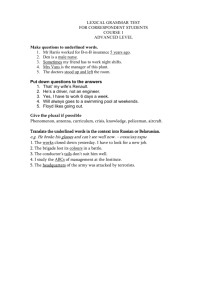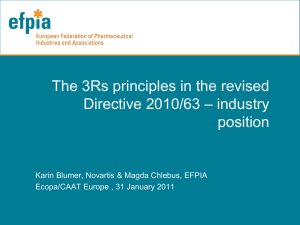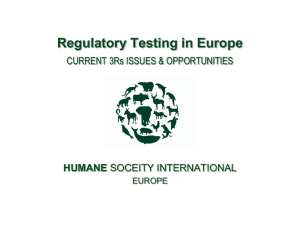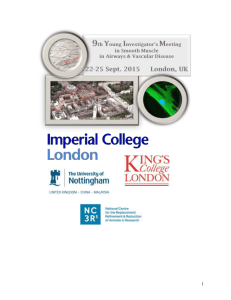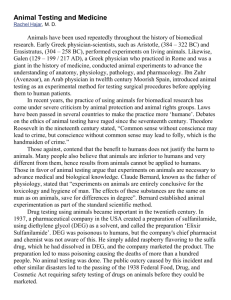Animal Testing – Science or Tradition?
advertisement
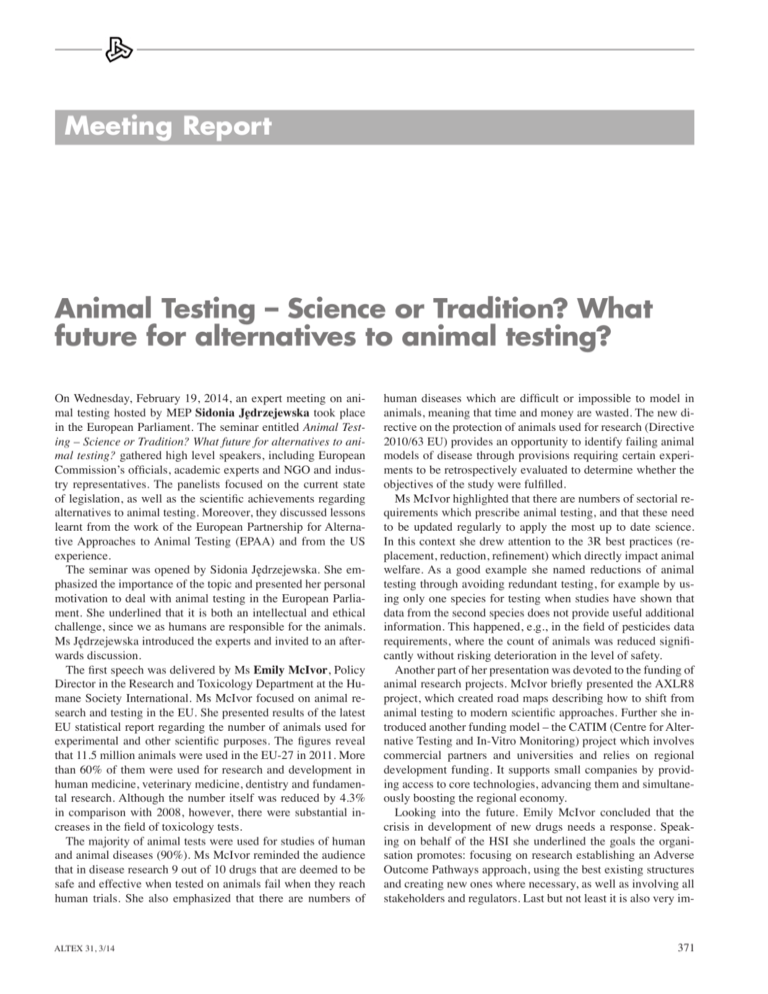
Meeting Report Animal Testing – Science or Tradition? What future for alternatives to animal testing? On Wednesday, February 19, 2014, an expert meeting on animal testing hosted by MEP Sidonia Jędrzejewska took place in the European Parliament. The seminar entitled Animal Testing – Science or Tradition? What future for alternatives to animal testing? gathered high level speakers, including European Commission’s officials, academic experts and NGO and industry representatives. The panelists focused on the current state of legislation, as well as the scientific achievements regarding alternatives to animal testing. Moreover, they discussed lessons learnt from the work of the European Partnership for Alternative Approaches to Animal Testing (EPAA) and from the US experience. The seminar was opened by Sidonia Jędrzejewska. She emphasized the importance of the topic and presented her personal motivation to deal with animal testing in the European Parliament. She underlined that it is both an intellectual and ethical challenge, since we as humans are responsible for the animals. Ms Jędrzejewska introduced the experts and invited to an afterwards discussion. The first speech was delivered by Ms Emily McIvor, Policy Director in the Research and Toxicology Department at the Humane Society International. Ms McIvor focused on animal research and testing in the EU. She presented results of the latest EU statistical report regarding the number of animals used for experimental and other scientific purposes. The figures reveal that 11.5 million animals were used in the EU-27 in 2011. More than 60% of them were used for research and development in human medicine, veterinary medicine, dentistry and fundamental research. Although the number itself was reduced by 4.3% in comparison with 2008, however, there were substantial increases in the field of toxicology tests. The majority of animal tests were used for studies of human and animal diseases (90%). Ms McIvor reminded the audience that in disease research 9 out of 10 drugs that are deemed to be safe and effective when tested on animals fail when they reach human trials. She also emphasized that there are numbers of Altex 31, 3/14 human diseases which are difficult or impossible to model in animals, meaning that time and money are wasted. The new directive on the protection of animals used for research (Directive 2010/63 EU) provides an opportunity to identify failing animal models of disease through provisions requiring certain experiments to be retrospectively evaluated to determine whether the objectives of the study were fulfilled. Ms McIvor highlighted that there are numbers of sectorial requirements which prescribe animal testing, and that these need to be updated regularly to apply the most up to date science. In this context she drew attention to the 3R best practices (replacement, reduction, refinement) which directly impact animal welfare. As a good example she named reductions of animal testing through avoiding redundant testing, for example by using only one species for testing when studies have shown that data from the second species does not provide useful additional information. This happened, e.g., in the field of pesticides data requirements, where the count of animals was reduced significantly without risking deterioration in the level of safety. Another part of her presentation was devoted to the funding of animal research projects. McIvor briefly presented the AXLR8 project, which created road maps describing how to shift from animal testing to modern scientific approaches. Further she introduced another funding model – the CATIM (Centre for Alternative Testing and In-Vitro Monitoring) project which involves commercial partners and universities and relies on regional development funding. It supports small companies by providing access to core technologies, advancing them and simultaneously boosting the regional economy. Looking into the future. Emily McIvor concluded that the crisis in development of new drugs needs a response. Speaking on behalf of the HSI she underlined the goals the organisation promotes: focusing on research establishing an Adverse Outcome Pathways approach, using the best existing structures and creating new ones where necessary, as well as involving all stakeholders and regulators. Last but not least it is also very im- 371 Meeting Report portant to remind and convince regulators, scientists and journalists that animal methods are not “gold standard.” Renate Weissenhorn (Advisor in the European Partnership for Alternative Approaches to Animal Testing, European Commission, DG Enterprise and Industry) and Dr Tzutzuy Ramirez (EPAA Industry Co-Chair, Head of Development of Alternative Methods in BASF – The Chemical Company) presented the work of the European Partnership for Alternative Approaches to Animal Testing created in 2005. This unique public-private partnership gathers representatives of industry and the European Commission. It promotes the use of 3Rs principles and the development of alternative testing methods through enhanced cooperation between the EPAA partners. What makes the EPAA special is also its cross sectorial approach. The partnership brings together 37 companies from different sectors, 5 Commission DGs and European trade federations. EPAA’s vision focuses on the 3Rs principle: replacement, reduction and refinement of animal use for meeting regulatory requirements through better and more predictive science. Ms Weissenhorn underlined that EPAAis promoting the development and acceptance of alternative methods, enhancing international collaboration, fostering knowledge sharing on 3Rs among the partners and facilitating dialogue between stakeholders. She presented also a short summary of EPAA activities in 2013. The partnership organized 11 projects on science and regulation, 6 specific workshops, 2 external events and published 2 papers. EPAA is also continuously improving the approach, e.g., by addressing new partners. In recent years EPAA launched dialogue with national regulators and with the European Parliament through the Intergroup on the Welfare and Conservation of Animals; it organized a joint stakeholder event with SEURAT (“Safety Evaluation Ultimately Replacing Animal Testing”) and created a 3Rs laboratory technician prize. It is also working on international projects dedicated to vaccines consistency approach, harmonization of biological and stem cells projects. EPAA launched as well an international cooperation with Russia, China, Brazil and the US. Dr Ramirez presented two examples of on-going specific research projects done by EPAA – one from the platform on regulation and one from the platform on science. The first project is devoted to optimized testing strategies for skin allergy. The incentive to start the project was that currently there are no regulatory accepted alternative methods for addressing the endpoint without animal testing. Dr Ramirez underlined, that there are already scientific achievements in the field, and some methods are in the final or advanced stage of validation, however they still need to be accepted under the regulatory framework. In this context, the EPAA is trying to facilitate the dialogue between regulators, industry, academia and validation bodies. The goal of the project is to provide deeper insight, share industry experience in this field and find methods to implement already existing tools into a regulatory framework. The project involves DG ENTR and DG JRC from the European Commission, as well as several industry sectors, ECHA and national regulators. The project steps contain several activities from 2010 to 2015. In the framework of the project several workshops were 372 organized, which enabled the partners to exchange their experience and also to try to gain acceptance for alternative methods. Dr Ramirez emphasized that it is essential to promote a better understanding of the new technologies and make clear to regulators that the safety levels should not be compromised or reduced while replacing animal testing. The next project presented relates to the platform on science and deals with the potential use of non-embryonic stem cells for safety assessment. Its goal is to identify the potential of applying non-embryonic stem cells for developing new alternative methods that could be used for toxicology. It focuses on concentrating information and setting up a forum for sharing industry and academic experience on stem cell research. Dr Ramirez concluded that the EPAA’s approach of a public-private partnership is a truly unique initiative. With the strong commitment from the partners it addresses the challenges of toxicology of the 21st century. It is trying to ensure the safety of the products and to enhance the implementation of the 3Rs principle. The following presentation by Prof. Coenraad Hendriksen (animal welfare officer and senior scientist at the Institute for Translational Vaccinology (Intravacc) and Chairholder “Alternatives to Animal Use” at the Utrecht University, Faculty of Veterinary Medicine) was devoted to animal testing and quality control of vaccines. Prof. Hendriksen highlighted that the use of animal testing for biological purposes is very extensive. In this field the animals are used to ensure the potency and safety of vaccines. According to regulations each vaccine batch release is tested on animals. In this context, it is important to mention that the applied quality control tests were developed between the 1950’s and 1980’s. They are based on traditional procedures used already in the 19th century. Moreover, the tests have never been subject to contemporary validation criteria. In the opinion of Prof. Hendriksen several of the animal models are highly artificial, poorly understood and have questionable relevance. Regarding the central question of the expert seminar, Prof. Hendriksen admitted that in the field of vaccines, animal testing is indeed tradition, but still ensuring safety and effectiveness of quality control. However, there is room for improvement. Prof. Hendriksen presented a summary of alternative methods which could replace traditional animal testing. Their implementation might be successfully supported by the 3Rs principles newly introduced into EU legislation. Following the replacement, refinement, reduction triada makes the new tests less time consuming, more science based and easier to standardize. Nevertheless, Hendriksen pointed out, that there are several limitations of the 3Rs principles. First of all the 3Rs principle does not necessarily mean that there is a full replacement of the animal tests, the validation studies are tedious and do not make use of improvement in process technologies. In the last part of his speech Prof. Hendriksen presented consistency testing which could replace the traditional paradigm of vaccine batch release testing. In this approach animal testing is restricted to the first few batches of a new seed lot. It uses in vivo data from clinical and pre-clinical studies and non-animal data. The subsequent batches could be tested for consistency in production with a fingerprint without using animals. Prof. Altex 31, 3/14 Meeting Report Hendriksen presented several conditions for this new approach including taking into account manufacturer and product specifics, identification of alert and regulatory acceptance criteria, as well as the interaction of manufacturer and regulatory authority. He emphasized that the manufacturers are reluctant to invest in alternative tests without having assurance of regulatory acceptance. At the same time and the other way around, the regulators are reluctant to assure acceptance in the absence of sufficient data. In his conclusion he highlighted scientific and economic advantages of the consistency approach as well as the animal welfare benefit. The quality is linked to well-characterized clinical batches, the quality control is quicker which makes it economically beneficial and there are substantial reductions in the use of animals required for batch release testing. In his conclusion Prof. Hendriksen linked the new approach of vaccine quality tests to the collaboration with EPAA. He mentioned that EPAA offers a platform to develop consistency testing. He underlined that it is very important to have the commitment of the industry, regulatory authorities and academia, as well as effective funding for additional scientific studies. His last words were devoted to the reconsideration on validation strategies, since many of them are not relevant anymore and there is a need to develop new approaches. The last speaker was Dr Francois Busquet, toxicologist and EU policy coordinator at the Center for Alternatives to Animal Testing (CAAT) Europe – a joint venture between the University of Konstanz, Germany, and Johns Hopkins University, Baltimore, US. In his presentation Toxicology for the 21st century in the US he focused on the US approach to animal testing and its alternatives. In the beginning Dr Busquet presented CAAT and its activities. The main part of Dr Busquet’s speech focused on the American perspective. He presented figures linked to animal testing: There are about 85-100 million vertebrates used worldwide. Regarding financial figures, toxicological studies are regulating more than $10 trillion worth of products and cost approximately $3 billion. The budget of the US research initiative “Tox21” already amounts to more than $100 million. The US federal R&D budget in the year 2013 equaled $133 billion. With regard to the American regulatory framework, Dr Busquet explained the relevant regulatory acts and institutions linked with 3Rs and animal testing. The US adopted the Animal Welfare Act in 1966, however, mice, rats and birds do not fall under its definition. Apart from that Dr Busquet presented the main regulatory agencies like the Food and Drug Administration (FDA), which deals with drugs, cosmetics and food. Regarding cosmetics, it is the responsibility of the producer to ensure the safety of the product and therefore the producer has the freedom to choose the most relevant tests – the FDA can only advise on those tests. Since the FDA approves the drugs for sale, they can be more proactive in implementing the 3Rs here. Regarding the US EPA (Environmental Protection Agency) Dr Busquet underlined that pesticides are regulated and the safety levels are very high, while the standards for new industrial chemicals are comparatively low. He also mentioned ICCVAM (Interagency Coordinating Committee on the Validation of Alternative Meth- Altex 31, 3/14 ods), which deals with validation and approval of alternative test methods in the US. Contrary to the EU, where policy makers and NGOs were at the forefront to drive the 3Rs implementation, it was the US regulatory agencies that pushed 3Rs and looked back to their tools. Dr Busquet quoted the NAS (National Academy of Sciences) vision report on Tox-21c commissioned by EPA, which states: “Traditional toxicological testing is based largely on the use of laboratory animals. However, this approach suffers from low throughput, high cost, and difficulties inherent to interspecies extrapolation – making it of limited use in evaluating the very large number of chemicals with inadequate toxicological data.” Dr Busquet underlined that the approach is very rational and less driven by ethics than it is in the EU. A statement from the National Toxicology Program, the U.S. Department of Health and Human Services confirmed “the availability of relevant tools arising from the technological advances in molecular biology and computer science which enable to replace the animal models for toxicological testing. The new tools are cost and time efficient, they also create a potential for developing alternative test methods.” Dr Busquet supported this by giving an example: It can cost up to $10 million and take five years to fully test a single pesticide (mostly using animals) before being put on the market. Whereas with ToxCast™, the whole panel of tests costs about $30,000 per compound and takes only weeks for some specific endpoints. Afterwards Dr Busquet presented the foreseen Tox21 regulatory outputs. ToxCast™ was designed based on high-throughput in vitro assays already available on the market (validated or not). The ToxCast™ figures report 500 assays with 300 substances in the first phase (2007-2009) and during the second phase (20102013) there were already 800 assays with 1800 substances. He summed up the results of EDSP20 (endocrine disrupter screening program), which was not only very costly (up to $1 million per ingredient to be fully tested in Tier1), but also time-consuming to build (fifteen years to develop and validate all these tests). The new EDSP21 will focus on HTS (High-Throughput Screening) in vitro and in silico tools for Tier 1, which will enable to save time and money. Dr Busquet looked also at the development of drugs and their failure quota of more than 90% during clinical trials. He showed the example of the project called Human-on-Chip Approach, which aims at developing reliable micro-physiological models ensuring human safety. Apart from the US approach, Dr Busquet gave a worldwide overview on the ban of animal testing for cosmetics. He emphasized that the EU had a great impact on the rest of the world. There are several countries like India, Israel or Brazil (São Paulo State) which decided to introduce a total or partial ban on animal testing in the field of cosmetics and/or specific consumer products. He also compiled potential causes of the continuous use of laboratory animals. These are 1) 3000 years of tradition and know-how linked to this heritage, 2) lack of contract research organizations (CROs) that would be able to perform alternative test methods for companies, 3) 28 national regulatory agencies in the EU with different levels of 3Rs awareness and ambition, 4) shortcomings of in vitro models and difficult endpoints as 373 Meeting Report well as 5) lacking manpower and R&D investments. Regarding the last point, Dr Busquet raised the issue of EU funding for alternatives to animal testing by the EU Member States. He drew attention to the article written by Katy Taylor, who described EU national contributions regarding financial support to alternative test methods (ALTEX 31, 215-218, http://dx.doi.org/10.14573/ altex.1401061). According to Article 47 of Directive 2010/63/ EU, the Member States should make financial contributions for alternative methods. Dr Busquet stated that there are very few national R&D investments and therefore, there is a strong need to involve SMEs to raise Member States̓ interests. During the discussion participants raised concerns about the implementation of developed alternative methods as well as the collaboration between the stakeholders. The first intervention from the floor underlined that although all participants of the meeting come from different perspectives they all want to make better and more predictive science and deliver better products and services. The participant underlined that we need to work together and make sure that the scientific research studies result in implementation of new methods and not only in new publications. Dr Ramirez responded to the comment stressing that it is in fact very important that the alternative methods are not only developed, but also implemented. For this reason an open dialogue between all stakeholders is needed. It is especially important for the regulators to feel confident in implementing the alternative methods without reducing the level of safety. Ms McIvor replied that she would like to see the companies bringing forward data and sharing them in a more collaborative way. This step would provide more motivation in developing new methods. In response Dr Ramirez recalled that in several examples industry is already providing a lot of data, for instance, for skin allergy most of the methods that are under validation are coming from industry. However, the issue is not only about providing data, but also about receiving feedback. Dr Ramirez repeated that a dialogue is needed on how to better use the data. She underlined that we have to work together on strategies. Ms Weissenhorn stated regarding the discussed issue that there is a step between doing research and putting new methods on the market. Ms Weissenhorn admitted that we still need research and we need to put together the pieces of science that have been done in different research projects. In response, Dr Busquet drew the attention to the implementation of the directive on animal experiments at the national level. He reminded that the transposition of the directive was different in various EU countries. In Italy the regulations became stricter whereas in France there is less effort on the 3Rs. Ms Weissenhorn replied reminding on the subsidiarity principle and that the Member States are also responsible for the work of the national regulatory bodies. There were also further important contributions from the floor. Dr Patric Amcoff, Cosmetics Europe, emphasized that he is representing the only sector directly affected by the testing ban. He informed about the financial means (ca. 7 million € per year) invested into development of replacement methods in the cosmetic sector. He underlined that the ban, which was a political decision, needs to be accompanied by decisions on streamlined validation requirements for the cosmetics sector. At present, the EU validation requirements of alternatives constitute a major challenge in the development of new alternatives in the cosmetics area and considerably slow down regulatory acceptance of new alternatives. In his opinion this constitutes a serious threat to SMEs and cosmetics industry in general and may seriously affect the industry’s ability to operate in the long term perspective. Another representative from the industry sector, Mr Florian Vernay, Unilever, emphasized that there is a need for political support to establish the best possible environment to foster dialogue between scientists and regulators. He stated that the gaps in science are big, but when it comes to ensuring understanding between national regulatory authorities and scientists, the gap is even wider. The industry needs political support to have a good conversation in a safe environment without being accused of lobbying for particular methods. In his opinion there is significant room for progress. With regards to his presentation, Dr Busquet concluded that it would be interesting to link the development of the alternative methods to the Transatlantic Trade and Investment Partnership (TTIP). He repeated that in the US the industry sector is responsible for the data, they are pushing, and therefore, it would be a good way to spread the news. The host of the event, Ms Sidonia Jędrzejewska, thanked the experts and participants for their fruitful input during the discussion. She stressed that the issue of animal testing and the efforts of industry, regulators and scientists to replace it with alternative methods are usually unknown for the end users. Therefore, often extreme views are presented in the debate. People either support a complete ban of animal testing and a shift towards alternatives or they defend traditional methods as the only way to guarantee the safety of the products. Ms Jędrzejewska concluded that it is important to combine common sense with compassion and that she believes that someday we will get rid of animal testing. Sidonia Jędrzejewska Member of the European Parliament (2009-2014) 374 Altex 31, 3/14
